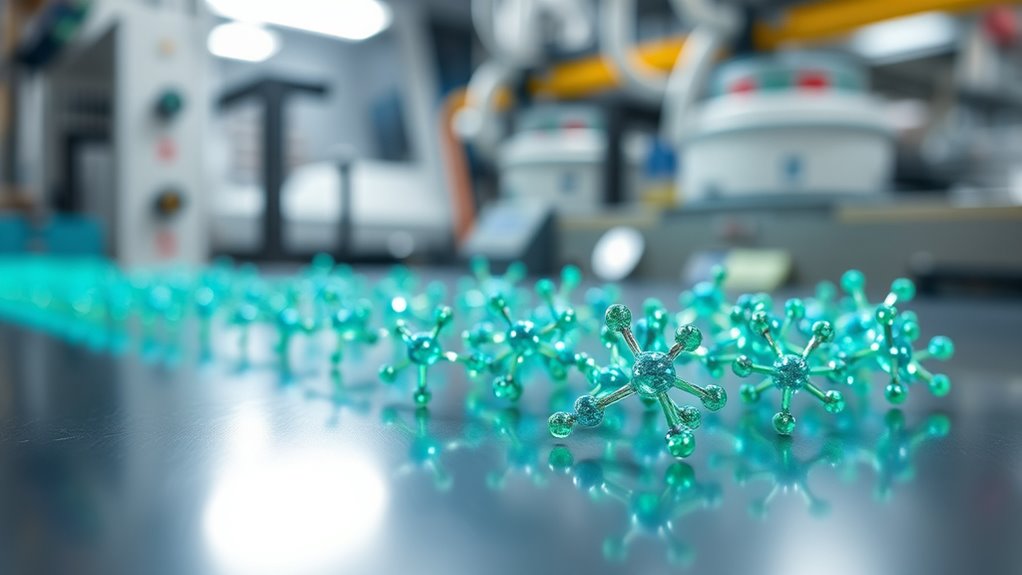Nanocatalysts can make industrial processes cleaner and more efficient by increasing reaction speeds, reducing energy use, and cutting harmful emissions. Their tiny size provides more active sites, helping transform pollutants into less harmful substances at lower temperatures. They also support sustainable manufacturing by minimizing waste and energy consumption. If you keep exploring, you’ll discover how these advanced catalysts are transforming industries toward greener, more environmentally friendly operations.
Key Takeaways
- Nanocatalysts increase reaction efficiency and reduce energy consumption in industrial processes.
- Their high surface area enhances pollutant conversion, supporting cleaner emissions and environmental compliance.
- They enable lower-temperature reactions, decreasing greenhouse gas emissions and operational costs.
- Nanocatalysts facilitate targeted pollutant removal, minimizing waste and byproducts.
- Their durability and efficiency promote sustainable manufacturing, reducing environmental impact.
Understanding Nanocatalysts and Their Unique Properties
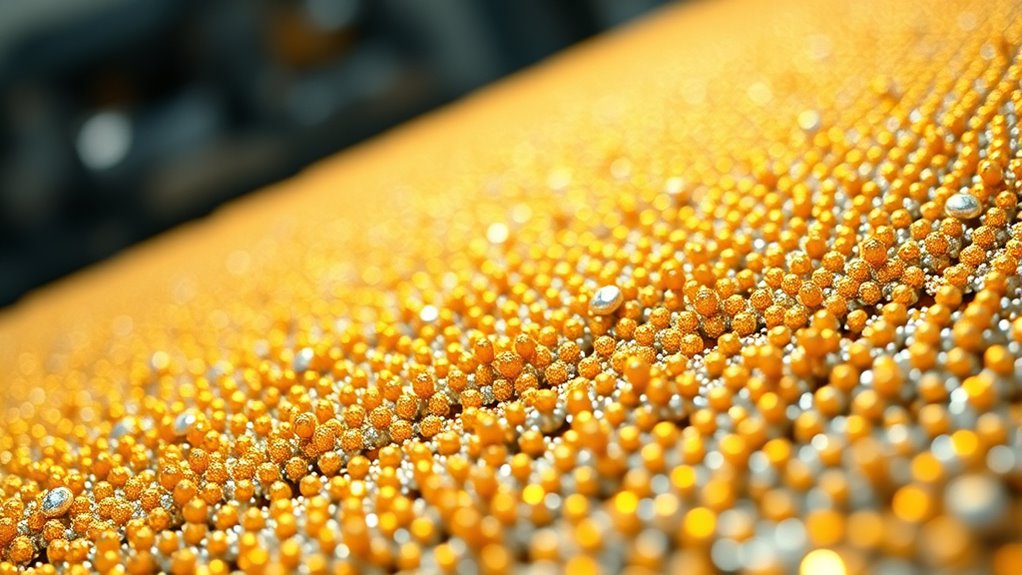
Nanocatalysts are incredibly small particles, typically less than 100 nanometers in size, that possess distinctive physical and chemical properties compared to their bulk counterparts. Because of their tiny size, you’ll notice they have a much higher surface area-to-volume ratio, which means more active sites are available for reactions. This increased surface area enhances their catalytic efficiency, allowing reactions to occur faster and under milder conditions. Additionally, nanocatalysts often exhibit unique electronic and optical properties, such as altered reactivity and improved selectivity. You’ll also find that their small size makes them more adaptable, enabling you to design catalysts tailored for specific reactions. These properties make nanocatalysts highly effective tools for advancing cleaner, more sustainable industrial processes. Their high surface area-to-volume ratio is a critical factor in maximizing catalytic activity and efficiency.
The Role of Nanocatalysts in Reducing Industrial Emissions
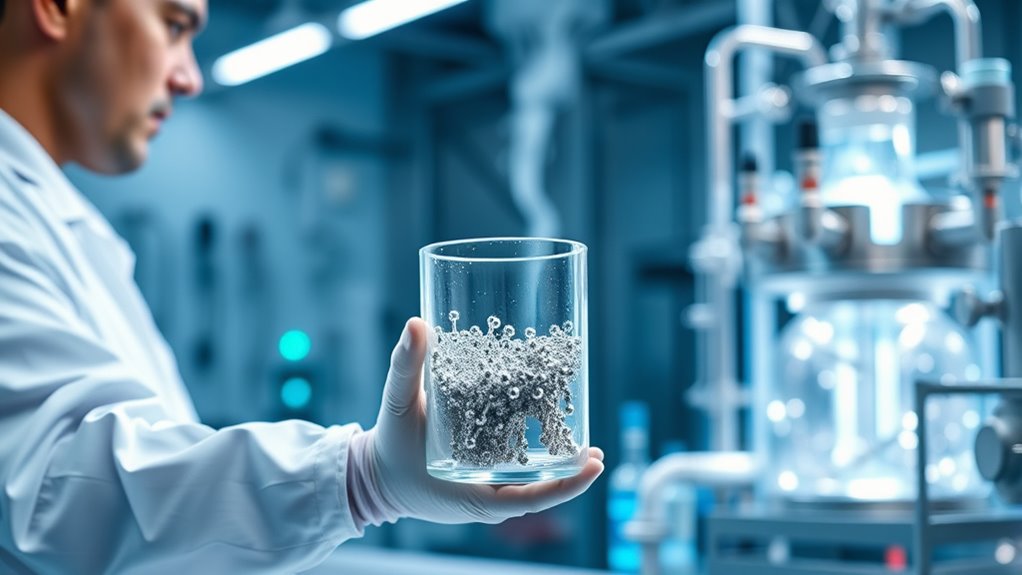
Because of their high surface area and unique reactivity, nanocatalysts play a crucial role in reducing industrial emissions. They enhance reaction efficiency, allowing pollutants like NOx, SOx, and unburned hydrocarbons to be converted into less harmful substances more effectively. By accelerating catalytic processes, nanocatalysts enable industries to lower their emissions without sacrificing productivity. Their small size provides more active sites, which improves the breakdown of hazardous emissions at lower temperatures, reducing energy consumption and secondary pollution. Additionally, nanocatalysts can be tailored to target specific pollutants, increasing selectivity and minimizing byproducts. This precision helps industries meet strict environmental regulations and decrease their ecological footprint, contributing markedly to cleaner air and healthier communities. In the realm of Kia Tuning, innovative catalytic solutions are also being explored to optimize emissions control in automotive applications, further emphasizing the importance of advanced nanomaterials.
Enhancing Energy Efficiency With Nanoscale Catalysts

Enhancing energy efficiency in industrial processes is crucial for reducing operational costs and minimizing environmental impact. Nanoscale catalysts improve this efficiency by speeding up reactions at lower temperatures and pressures, which conserves energy. Their high surface area provides more active sites, allowing reactions to occur more rapidly and completely. This means less energy is wasted, and processes run more smoothly. By integrating nanocatalysts, you can optimize reaction conditions, leading to significant energy savings over time. Their durability also ensures consistent performance, reducing downtime and maintenance. Additionally, efficient catalyst design is essential for maximizing these benefits and achieving sustainable manufacturing goals. Overall, nanoscale catalysts enable industries to operate more sustainably, lowering energy consumption while maintaining high product quality. This approach not only cuts costs but also supports your commitment to eco-friendly practices.
Applications of Nanocatalysts in Chemical Manufacturing

The chemical manufacturing industry benefits considerably from the integration of nanocatalysts, which actively accelerate reaction rates and improve process efficiency. You can see their impact in producing fuels, plastics, and pharmaceuticals more sustainably. Nanocatalysts enable lower reaction temperatures and reduced energy consumption, cutting costs and emissions. They also enhance selectivity, minimizing byproducts and waste. In processes like hydrogenation, oxidation, and polymerization, nanocatalysts improve yields and speed up production cycles. Their high surface area allows for more active sites, making reactions more efficient. You’ll find nanocatalysts replacing traditional catalysts in many industrial applications, driving cleaner manufacturing practices. By adopting these advanced catalysts, you help reduce environmental impact while increasing productivity and product quality.
Challenges and Safety Considerations in Nanocatalyst Deployment
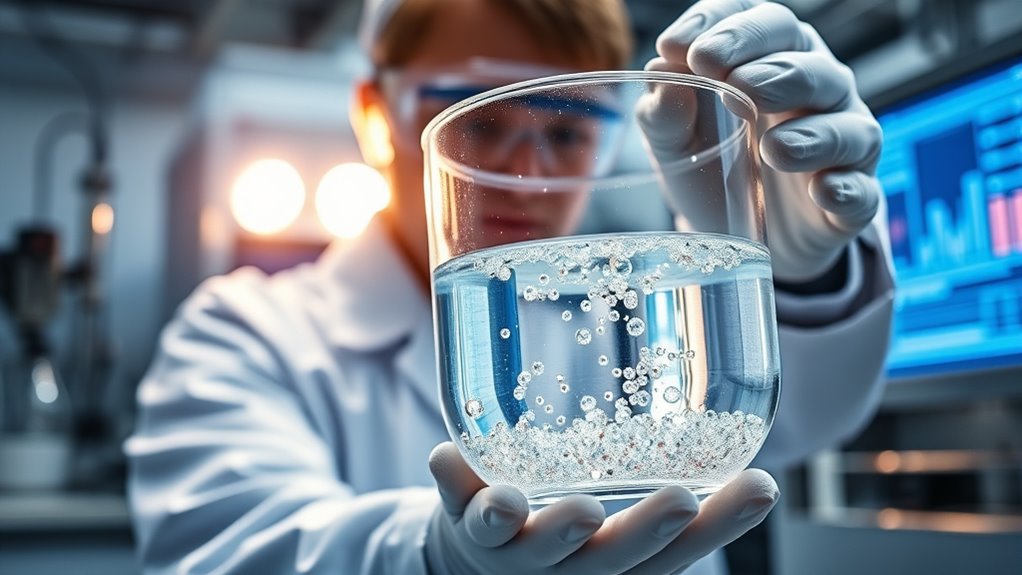
While nanocatalysts offer significant advantages for cleaner industrial processes, their deployment also presents notable challenges and safety concerns. You must address issues related to nanoparticle stability, as they can agglomerate or degrade, reducing effectiveness. Handling nanomaterials poses health risks, including inhalation or skin exposure, requiring strict safety protocols. Environmental concerns also arise, since nanoparticles may persist or accumulate, potentially harming ecosystems. Regulatory frameworks are still evolving, making it difficult to ensure compliance and safe use across industries. You need to implement rigorous safety measures, such as proper containment and disposal procedures, to mitigate risks. Additionally, understanding long-term impacts remains limited, so ongoing research and cautious application are essential to balance innovation with safety. Moreover, understanding Dog names offers insights into selecting appropriate names that reflect personality and breed characteristics.
Innovations and Future Trends in Nanocatalyst Technology

Advancements in synthesis methods are enabling you to create more efficient and selective nanocatalysts. Emerging application areas, such as renewable energy and environmental remediation, show promising growth potential. Staying informed about these innovations helps you anticipate the future landscape of nanocatalyst technology. For instance, leveraging highly active catalysts can significantly improve process efficiency and sustainability.
Advanced Synthesis Methods
Innovations in synthesis methods are driving the development of nanocatalysts with enhanced efficiency and selectivity. Techniques like sol-gel processes, atomic layer deposition, and microwave-assisted synthesis allow you to guarantee control particle size, shape, and distribution at the nanoscale. These methods enable precise tuning of catalytic properties, leading to higher activity and durability. You can now incorporate greener approaches, such as aqueous or solvent-free routes, reducing environmental impact. Additionally, self-assembly and bio-inspired strategies offer new pathways for creating complex nanostructures with tailored functionalities. As you adopt these advanced techniques, you’ll improve catalyst performance, stability, and scalability, paving the way for more sustainable industrial processes. Continuous innovation in synthesis methods ensures nanocatalysts meet the evolving demands of cleaner, more efficient manufacturing.
Emerging Application Areas
Have you considered how emerging application areas are transforming nanocatalyst technology? As innovations expand, nanocatalysts now play crucial roles beyond traditional industries. In environmental remediation, they help break down pollutants more efficiently, leading to cleaner air and water. In renewable energy, nanocatalysts improve hydrogen production and fuel cell performance, advancing sustainable solutions. The pharmaceutical sector benefits from targeted drug synthesis, reducing waste and increasing precision. Additionally, nanocatalysts are entering waste management processes, enabling more effective recycling. Future trends point toward multifunctional nanocatalysts tailored for specific reactions, increasing efficiency and reducing costs. As research progresses, you’ll see nanocatalysts becoming integral to cleaner, greener industrial processes across multiple sectors, shaping a sustainable future. Contrast ratio plays a role in optimizing the efficiency and clarity of nanocatalyst visualization in applications.
Case Studies Demonstrating Sustainable Industrial Transformations
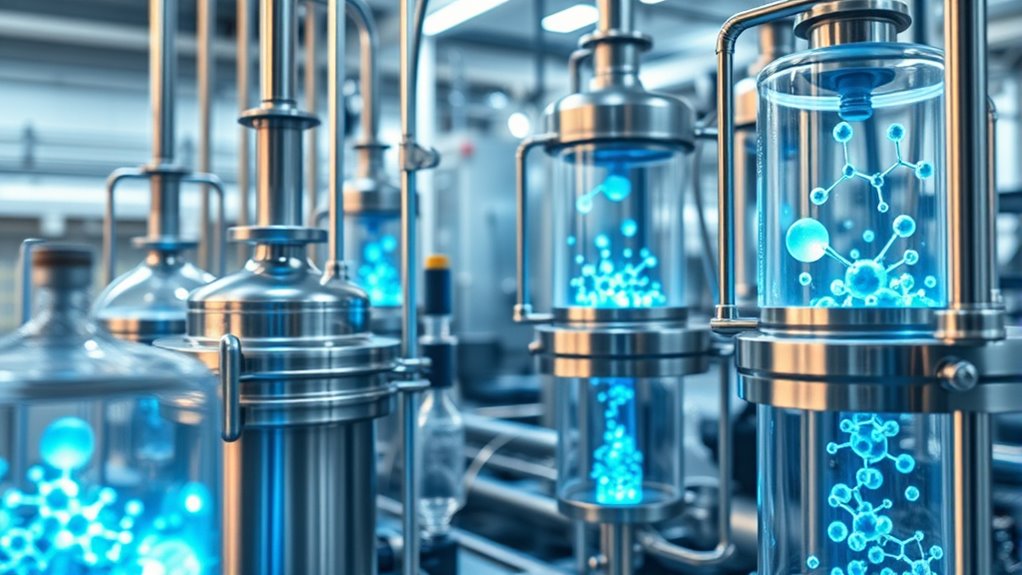
One compelling example of sustainable industrial transformation involves the adoption of nanocatalysts in chemical manufacturing processes. You can see significant improvements in efficiency, reducing waste and energy consumption. For instance, a pharmaceutical company replaced traditional catalysts with nanocatalysts, cutting reaction times and lowering emissions. This shift demonstrates how nanotechnology fosters greener methods. To highlight benefits, consider this table:
| Traditional Catalysts | Nanocatalysts |
|---|---|
| Lower surface area | Higher surface area for reactions |
| Longer reaction times | Faster reactions |
| Higher waste output | Reduced waste |
| Greater energy use | Lower energy requirements |
| Limited selectivity | Improved selectivity |
This transformation shows how nanocatalysts help industries become more sustainable while maintaining productivity. Advances in nanotechnology continue to drive innovations toward greener industrial processes.
Frequently Asked Questions
How Do Nanocatalysts Impact the Lifecycle of Industrial Equipment?
Nanocatalysts extend the lifecycle of your industrial equipment by enhancing efficiency and reducing wear and tear. They enable reactions to occur more quickly and at lower temperatures, decreasing stress on machinery. As a result, you experience less frequent maintenance and downtime. Additionally, their high activity means less catalyst degradation over time, allowing your equipment to operate reliably longer, saving you costs and improving overall industrial process sustainability.
Are Nanocatalysts Environmentally Safe After Use?
Nanocatalysts can be environmentally safe after use if properly managed. You should guarantee they are disposed of or recycled according to regulations to prevent environmental contamination. When used correctly, nanocatalysts tend to be stable and less toxic than traditional catalysts, reducing harmful waste. However, you need to stay informed about potential nanoparticle release and handle them responsibly to minimize any environmental or health risks.
What Are the Costs Associated With Implementing Nanocatalyst Technology?
You’ll find implementing nanocatalyst technology costs more than you’d expect, but it’s worth the investment. The expenses include developing and producing advanced nanomaterials, upgrading equipment, and training staff. While initial costs might seem intimidating, you’ll save money long-term through increased efficiency and reduced environmental penalties. So, yes, it’s a pricey step, but one that promises a cleaner, more sustainable future—just don’t forget to budget for the “tiny” price tag.
How Scalable Are Nanocatalyst Production Methods?
You can scale nanocatalyst production quite effectively, especially with advancements in synthesis techniques like chemical vapor deposition and sol-gel methods. These methods are adaptable for large-scale manufacturing, allowing you to produce significant quantities while maintaining quality. As demand grows, you’ll find that process optimization and automation further improve scalability, making it feasible to meet industrial needs efficiently without compromising performance or cost-effectiveness.
Can Nanocatalysts Be Customized for Specific Industrial Processes?
You can definitely customize nanocatalysts for specific industrial processes. By tweaking their size, shape, and surface properties, you target particular reactions more efficiently. This customization enhances catalytic activity and selectivity, leading to cleaner, more sustainable operations. Advances in nanotechnology allow you to design catalysts tailored precisely to your process needs, reducing waste and energy consumption. So, yes, customization is not only possible but also a key to optimizing industrial efficiency.
Conclusion
Think of nanocatalysts as tiny revolutionaries guiding industry toward a greener future. Their power lies in transforming complex processes into cleaner, more efficient actions—like skilled artisans chiseling away waste to reveal pure gold. By embracing these nanoscale heroes, you become part of a movement that turns industrial challenges into opportunities for sustainability and innovation. Together, you can forge a path where technology and nature work hand in hand for a cleaner, brighter tomorrow.
